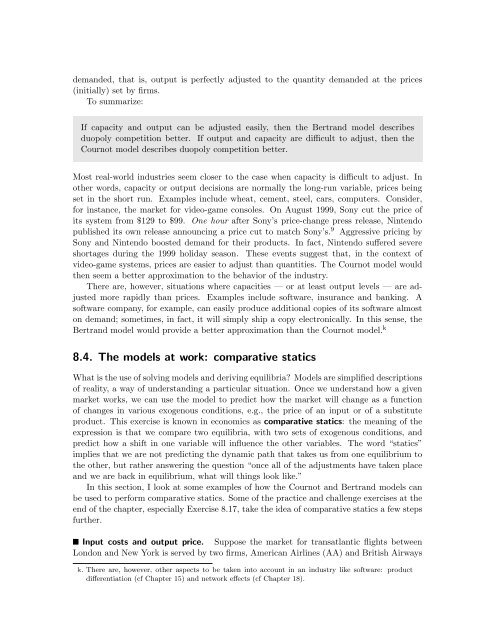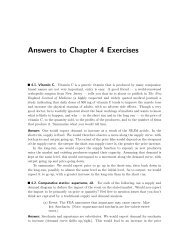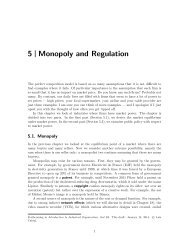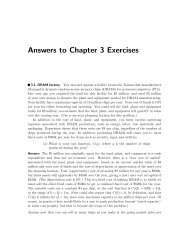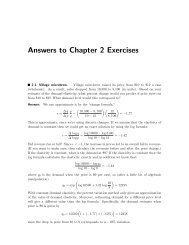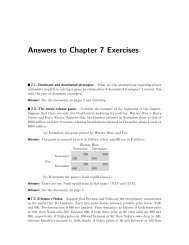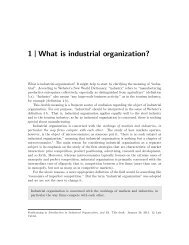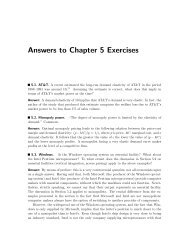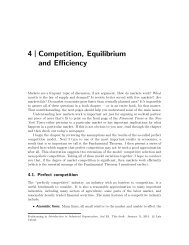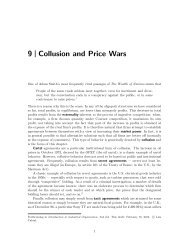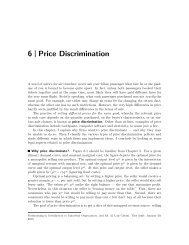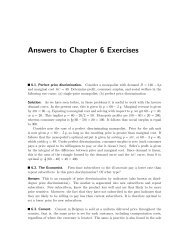8 Oligopoly - Luiscabral.net
8 Oligopoly - Luiscabral.net
8 Oligopoly - Luiscabral.net
Create successful ePaper yourself
Turn your PDF publications into a flip-book with our unique Google optimized e-Paper software.
demanded, that is, output is perfectly adjusted to the quantity demanded at the prices<br />
(initially) set by firms.<br />
To summarize:<br />
If capacity and output can be adjusted easily, then the Bertrand model describes<br />
duopoly competition better. If output and capacity are difficult to adjust, then the<br />
Cournot model describes duopoly competition better.<br />
Most real-world industries seem closer to the case when capacity is difficult to adjust. In<br />
other words, capacity or output decisions are normally the long-run variable, prices being<br />
set in the short run. Examples include wheat, cement, steel, cars, computers. Consider,<br />
for instance, the market for video-game consoles. On August 1999, Sony cut the price of<br />
its system from $129 to $99. One hour after Sony’s price-change press release, Nintendo<br />
published its own release announcing a price cut to match Sony’s. 9 Aggressive pricing by<br />
Sony and Nintendo boosted demand for their products. In fact, Nintendo suffered severe<br />
shortages during the 1999 holiday season. These events suggest that, in the context of<br />
video-game systems, prices are easier to adjust than quantities. The Cournot model would<br />
then seem a better approximation to the behavior of the industry.<br />
There are, however, situations where capacities — or at least output levels — are adjusted<br />
more rapidly than prices. Examples include software, insurance and banking. A<br />
software company, for example, can easily produce additional copies of its software almost<br />
on demand; sometimes, in fact, it will simply ship a copy electronically. In this sense, the<br />
Bertrand model would provide a better approximation than the Cournot model. k<br />
8.4. The models at work: comparative statics<br />
What is the use of solving models and deriving equilibria? Models are simplified descriptions<br />
of reality, a way of understanding a particular situation. Once we understand how a given<br />
market works, we can use the model to predict how the market will change as a function<br />
of changes in various exogenous conditions, e.g., the price of an input or of a substitute<br />
product. This exercise is known in economics as comparative statics: the meaning of the<br />
expression is that we compare two equilibria, with two sets of exogenous conditions, and<br />
predict how a shift in one variable will influence the other variables. The word “statics”<br />
implies that we are not predicting the dynamic path that takes us from one equilibrium to<br />
the other, but rather answering the question “once all of the adjustments have taken place<br />
and we are back in equilibrium, what will things look like.”<br />
In this section, I look at some examples of how the Cournot and Bertrand models can<br />
be used to perform comparative statics. Some of the practice and challenge exercises at the<br />
end of the chapter, especially Exercise 8.17, take the idea of comparative statics a few steps<br />
further.<br />
Input costs and output price. Suppose the market for transatlantic flights between<br />
London and New York is served by two firms, American Airlines (AA) and British Airways<br />
k. There are, however, other aspects to be taken into account in an industry like software: product<br />
differentiation (cf Chapter 15) and <strong>net</strong>work effects (cf Chapter 18).


